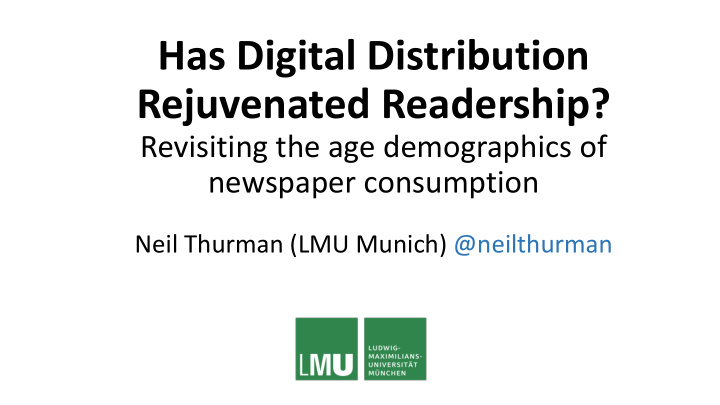



Has Digital Distribution Rejuvenated Readership? Revisiting the age demographics of newspaper consumption Neil Thurman (LMU Munich) @neilthurman
Cross platform monthly reach Advertising income , (UK national newspapers) UK newspaper brand s Millions 3500 18 Millions 16 3000 14 2500 12 10 2000 8 1500 6 1000 4 2 500 0 Jan 14 – July 14 – Jan 15 – July 15 – Jan 16 – July 16 – 0 Dec 14 Jun 15 Dec 15 June 16 Dec 16 Jun 17 2012 2013 2014 2015 2016 2017 Source: AA/WARC and PAMCo
?
Print survey data Passive online (e.g. from national measurement data ‘Fusion’ readership (e.g. from surveys) comScore) Net (de-duplicated) readership reported over common time periods 4
Frequency 73% of print readers read it Online visitors visit an “almost always” (i.e. every av. of three times a day ), with 13 percent reading month (comScore 2016) . them “quite often” ( NRS 2017 ) . Print edition read for 55 – 86 Time- Online editions read for minutes per issue per reader 8.3 minutes per user / spent (NRS 2017) . per month (comScore 2016) .
Time spent Readership Time spent Y Y Number of readers N Y How frequently they read N Y How long they read
Total minutes spent reading by the aggregated British print, PC, and mobile readerships (18+) of each of 8 UK national newspaper brands, 2016 The Mail The Sun The Telegraph Print PC and mobile Mirror The Times 86% - print The Guardian 14% - online Standard Star 0 20 40 60 80 Billions minutes / year (Excludes time spent watching video on mobile)
Total attention (measured by time spent reading) received by The Independent from its British audience before it went online-only Print PC and mobile Time spent reading (milllions/mins) 500 450 400 350 26 March 2016. The 300 Independent stops printing Online time-spent and goes online-only. 250 changed <1% 200 150 100 50 0 Apr-15 May-15 Jun-15 Jul-15 Aug-15 Sep-15 Oct-15 Nov-15 Dec-15 Jan-16 Feb-16 Mar-16 Apr-16 May-16 Jun-16 Jul-16 Aug-16 Sep-16 Oct-16 Nov-16 Dec-16 Jan-17 Feb-17 Mar-17 Apr-17 Source: Thurman, N. & Fletcher, R. (2018) Are Newspapers Heading Towards Post- Print Obscurity? A Case Study of The Independent’s Transition to Online -only. Digital Journalism
• Change in time spent with newspaper brands since they started to be distributed in print and online? • Differences in behaviour of older, middle-aged, & younger readers an explanation?
comScore panels: National Readership Survey 72,000 PC users 33,225 sample in home interviews 6,000 mobile users + tagging 2016 1999/ 2000
Changes in total annual attention* received by eight UK national newspaper brands** between 1999/2000 and 2016 450 Billions of minutes 400 350 -40% 300 250 200 150 100 50 0 2016 1999/2000 2015 Note: Reading time for 2016 includes PC, mobile, and print audiences. Only print reading time is included in the 1999/2000 figures. In 1999/2000 the time spent reading online was insignificant for this sample of newspaper brands. * Measured by minutes spent reading. **Mail, Mirror, Star, Telegraph, Guardian, Sun, Evening Standard, and Times. Sources: NRS and comScore.
Age has been found to be the (Lauf 2001; McGrath 1993; Schlagheck 1998; Thurlow and Milo 1993) or one of the (Elvestad and Blekesaune 2008) most important determinants of newspaper use. Peiser , Wolfram. 2000. “Cohort Replacement and the Downward Trend in Newspaper Readership.” Newspaper Research Journal 21 (2): 11 – 22.
Changes in total annual attention* received by eight UK national newspaper brands** from their younger, middle-aged, and older British audiences between 1999/2000 and 2016 450 Billions of minutes 400 55+ 35-54 18-34 350 177 300 250 200 155 137 150 100 61 50 93 31 0 2016 1999/2000 2015 Note: Reading time for 2016 includes PC, mobile, and print audiences. Only print reading time is included in the 1999/2000 figures. In 1999/2000 the time spent reading online was insignificant for this sample of newspaper brands. * Measured by minutes spent reading. **Mail, Mirror, Star, Telegraph, Guardian, Sun, Evening Standard, and Times. Sources: NRS and comScore.
• Digital distribution not altered intra-cohort change & cohort effects… • … even when accounting for online editions and frequency & duration of consumption • Decline of newspaper brands, some way to go before it bottoms out
120 Billions of minutes / year Time spent with UK newspapers by their British audiences in: 100 2016 1999/2000 80 60 40 +19% +17% 20 0 1999/ 2016 1999/ 2016 1999/ 2016 1999/ 2016 1999/ 2016 1999/ 2016 1999/ 2016 1999/ 2016 2000 2000 2000 2000 2000 2000 2000 2000 The Mail Mirror The Sun Star Standard The The The Times Telegraph Guardian Sources: NRS and comScore.
Neil Thurman LMU Munich @neilthurman www.neilthurman.com
Recommend
More recommend